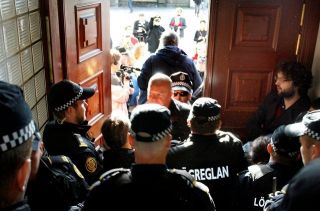The Guardian
Jórunn Edda Helgadóttir and Guðjón Idir
Nine protesters on trial for entering the Iceland parliament may be jailed despite a lack of evidence against them
Nine people went on trial in Iceland last week, charged with threatening the country’s parliament – a charge that has only been used once before and that carries a maximum life sentence. They were among 30 demonstrators who entered the parliament building via the visitors’ door during a small protest in December 2008 at a time when thousands of Icelanders took to the streets to express their outrage at the government’s part in the financial crisis.
Several precedents of vocal protests on the public balcony of parliament can be found, one of which a current MP, Össur Skarphéðinsson, organised and attended in 1976. No one has been charged for taking part in such action before – not even the group who donned army camouflage and carried replica machine guns to protest against Iceland’s decision to join the EEA in 1993.
The Reykjavik Nine are charged with a violation of a paragraph that falls under the article on terrorism in the Icelandic penal code, entitled “Attack on Parliament”. In April 2005 the United Nations Human Rights Committee complained of too broad and obscure a definition of terrorism in the code. It might, the committee said, “encompass and consequently jeopardise legitimate activity in a democratic society, in particular participation in public demonstrations”.
Now these concerns have been vindicated. If we assume the law on justice to be coherent, attacks on parliament should be interpreted as a more serious crime than terrorism: there is a minimum sentence for an attack on parliament, while there is none for terrorism. However, there is no sustainable evidence of intent of any kind of attack in the case against the Reykjavik Nine, nor of any violent behaviour or even threat of violence.
The evidence amounts to nothing more than the fact that on 8 December 2008, 30 people tried to go up to the public balcony of parliament to protest, and one of them managed to say a few words from it. From this group nine individuals were picked and charged at random.
During the trial at Reykjavik’s district court last week, a group of Reykjavik Nine supporters transcribed the whole trial in a live blog. This has never been done before in Iceland, but it proved necessary, as the local media had mostly shunned the story until the trial began and relied on statements from parliament and the police authorities, which brought the action. The live blog enabled the public to read what was actually happening during the trial.
Reflecting the shock and dismay among the public at the lack of evidence and reliable testimony, the Icelandic prime minister, Jóhanna Sigurðardóttir, expressed her sadness at the proceedings on her Facebook profile during the trials. Possibly the most embarrassing moment of the trial was an admission by the parliamentary security manager, Guðlaugur Ágústsson. Ágústsson testified that on his own initiative he decided to copy only a fraction of the proceedings from CCTV cameras, knowing full well that the rest would soon be automatically wiped.
As the defence pointed out, the prosecution did not even manage to establish that all the accused had ever been inside the parliament building, let alone on the day in question. What the trial – and a ruling will be issued within four weeks – did establish was a deeper and more widespread understanding of the fact that the prosecution has no prima facie case. The crime the Reykjavik Nine are accused of was never committed, and there is no evidence to suggest anyone intended to commit it.
Jórunn Edda Helgadottir and Guðjón Idir are both active supporters of the Reykjavik Nine and helped to blog their trial.
